
Pteranodon is a genus of pterosaur that included some of the largest known flying reptiles, with wingspans over 7 meters. They lived during the late Cretaceous geological period of North America in present-day Kansas, Alabama, Nebraska, Wyoming, and South Dakota. More fossil specimens of Pteranodon have been found than any other pterosaur, with about 1,200 specimens known to science, many of them well preserved with nearly complete skulls and articulated skeletons. It was an important part of the animal community in the Western Interior Seaway.

Anseriformes is an order of birds that comprise about 180 living species in three families: Anhimidae, Anseranatidae, and Anatidae, the largest family, which includes over 170 species of waterfowl, among them the ducks, geese, and swans. Most modern species in the order are highly adapted for an aquatic existence at the water surface. With the exception of screamers, males have penises, a trait that has been lost in the Neoaves. Due to their aquatic nature, most species are web-footed.
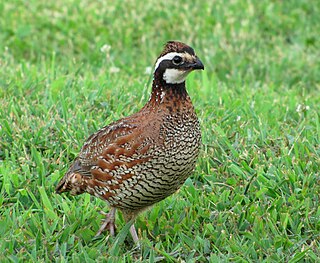
The New World quails are small birds only distantly related to the Old World quail, but named for their similar appearance and habits. The American species are in their own family, the Odontophoridae, whereas Old World quail are in the pheasant family Phasianidae. The family ranges from Canada through to southern Brazil, and two species, the California quail and the bobwhite quail, have been successfully introduced to New Zealand. The stone partridge and Nahan's partridge, both found in Africa, seem to belong to the family. Species are found across a variety of habitats from tropical rainforest to deserts, although few species are capable of surviving at very low temperatures. The 34 species are placed in 10 genera.
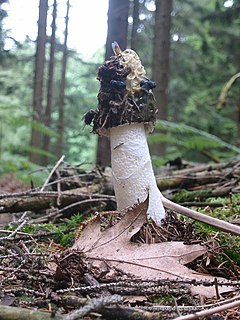
Phallaceae is a family of fungi, commonly known as stinkhorn mushrooms, within the order Phallales. Stinkhorns have a worldwide distribution, but are especially prevalent in tropical regions. They are known for their foul-smelling, sticky spore masses, or gleba, borne on the end of a stalk called the receptaculum. The characteristic fruiting-body structure, a single, unbranched receptaculum with an externally attached gleba on the upper part, distinguishes the Phallaceae from other families in the Phalalles. The spore mass typically smells of carrion or dung, and attracts flies, beetles and other insects to help disperse the spores. Although there is great diversity in body structure shape among the various genera, all species in the Phallaceae begin their development as oval or round structures known as "eggs". According to a 2008 estimate, the family contains 21 genera and 77 species.
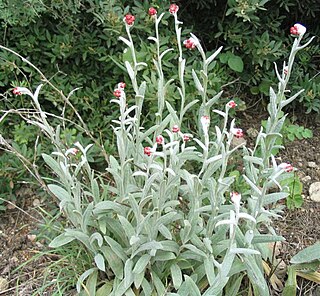
The genus Helichrysum consists of an estimated 600 species of flowering plants in the sunflower family (Asteraceae). The type species is Helichrysum orientale. The name is derived from the Greek words ἑλίσσω and χρῡσός.

Muscari is a genus of perennial bulbous plants native to Eurasia that produce spikes of dense, most commonly blue, urn-shaped flowers resembling bunches of grapes in the spring. The common name for the genus is grape hyacinth, but they should not be confused with hyacinths. In the United States, they are also commonly referred to as bluebells, though certain regions reserve this name for bluebonnets instead. A number of species of Muscari are used as ornamental garden plants.
The nonsense rat, Nicobar Archipelago rat, or Miller's Nicobar rat is endemic to the Nicobar Islands in India. It is found on Great Nicobar, Little Nicobar, and Trinket islands. On Car Nicobar Island, Rattus palmarum and Rattus anadamanensis are found instead of the nonsense rat.

Notodontidae is a family of moths with approximately 3,800 known species. The family was described by James Francis Stephens in 1829. Moths of this family are found in all parts of the world, but they are most concentrated in tropical areas, especially in the New World.

Acacia, commonly known as the wattles or acacias, is a large genus of shrubs and trees in the subfamily Mimosoideae of the pea family Fabaceae. Initially, it comprised a group of plant species native to Africa and Australasia, but it has now been limited to contain only the Australasian species. The genus name is New Latin, borrowed from the Greek ἀκακία, a term used by Dioscorides for a preparation extracted from the leaves and fruit pods of Vachellia nilotica, the original type of the genus. In his Pinax (1623), Gaspard Bauhin mentioned the Greek ἀκακία from Dioscorides as the origin of the Latin name.

The Heteroceridae, or variegated mud-loving beetles, are a widespread and relatively common family of beetles. They occur on every continent except for Antarctica.
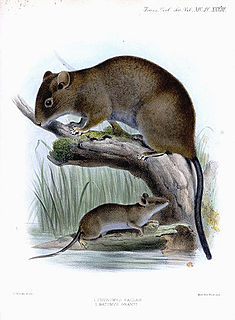
Batomys is a genus of rodent endemic to the Philippines. It has six extant described species.
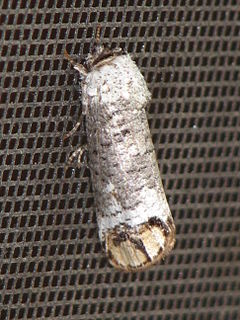
The Cossidae, the cossid millers or carpenter millers, make up a family of mostly large miller moths. This family contains over 110 genera with almost 700 known species, and many more species await description. Carpenter millers are nocturnal Lepidoptera found worldwide, except the Southeast Asian subfamily Ratardinae, which is mostly active during the day.

Blanford's fruit bat is a mountain species of megabat. It is found in several countries in South and Southeast Asia.

Monophyllus, the Antillean long-tongued bats, is a genus of bats in the family Phyllostomidae. They are distributed on the Antilles.

Orson Knapp Miller Jr. was an American mycologist. He published numerous papers in mycology and was responsible for the naming of many taxa, as well as being one of the authors erecting the genus Chroogomphus. He described Omphalotus olivascens, several species of Amanita, and the ghoul fungus Hebeloma aminophilum.

Adeleorina is a suborder of parasites in the phylum Apicomplexa.
Penestomus is a genus of African araneomorph spiders in the family Penestomidae, and was first described by Eugène Louis Simon in 1902. The genus was formerly included in the family Eresidae, but was elevated to its own family in 2010. It is now considered closer to Zodariidae.
Corallimorphus profundus is a species of corals in the genus Corallimorphus. It lives in marine habitats. This species can be found in the Southern Ocean and in New Zealand.

Eumops nanus is a species of bat found in Central and South America.
Homalocnemis is a genus of flies which is placed in a family of its own, the Homalocnemiidae. There are about seven species in the genus found in the Afrotropical, Neotropical, and Australasian regions, suggestive of a Gondwanan origin. The genus was formerly considered a primitive empidoid and placed variously in the Hybotidae or in the empidid subfamily Brachystomatinae. They are recognized by their wing venation which includes a long anal cell and a long basal segment of the antennal style.















